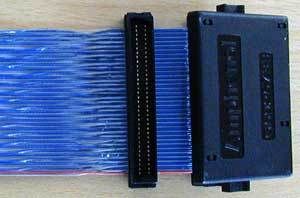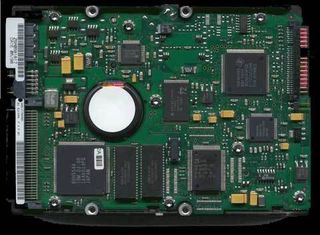A Look At SCSI-Performance: Fujitsu MAJ3364MC U160-SCSI
Hot Oldie: IBM DGVS UltraStar 9ZX

Two years ago we used to run our standard benchmarks with this nice IBM drive. At that time, the UltraStar 9 ZX was one of the fastest drives available. As you can see on the photo, it has a height of 1.6". The Fujitsu drive comes with four times the capacity at only 1" height. Today, only 72 GB enterprise drives have a height of 1.6".
The DGVS' seek time is still excellent even today, while the data transfer rate cannot keep pace with current models. Modern hard drives come with 2 MB or more cache memory today. The DGVS used only 1 MB, which used to be considered quite a lot two years ago.
| IBM DGVS UltraStar 9ZX Technical | |
|---|---|
| Capacity | 9.1 GB |
| Number Of Platters | 6 |
| Average Seek Time | 6.3 ms |
| Rotation Speed | 10,020 rpm |
| Interface | Ultra2Wide-SCSI |
| Buffer Size | 1 MB |
| Height | 1.6" |

IBM's UltraStar 9 ZX SCSI was available only with U2W-SCSI interface. At that time, the new SCSI cables with twisted wires became widely used:

That's an 68-pin twisted SCSI cable with terminator.
The first drive that worked at 10,000 rpm was Seagate's first Cheetah model, which was even louder and hotter than the IBM drive. Still, running the old UltraStar 9 ZX without at least a good airflow leads to temporary malfunctions and data losses. As you will see later, the Fujitsu drive does not get as hot any more, even though it works at the same rotation speed as the DGVS. It still requires cooling though.

At the right side of the drive you can see several micro-jumpers for drive configuration.
Since the DGVS was some kind of pioneer of the 10,000-rpm-technology, it was a totally flat footed drive, as it was both extremely hot and noisy and therefore hardly suited for the usage in a desktop system.
Stay on the Cutting Edge
Join the experts who read Tom's Hardware for the inside track on enthusiast PC tech news — and have for over 25 years. We'll send breaking news and in-depth reviews of CPUs, GPUs, AI, maker hardware and more straight to your inbox.
Current page: Hot Oldie: IBM DGVS UltraStar 9ZX
Prev Page Latest High-Tech: Fujitsu MAJ3364MC Next Page King Of IDE: IBM DTLA DeskStar 75GXP-
dltaylor I owned one of these things back in the day! And let me tell you, listening to that spin up made you feel like you were starting a small jet. And yes, the clicking got old pretty quick if you're used to quietness.Reply
Most Popular

